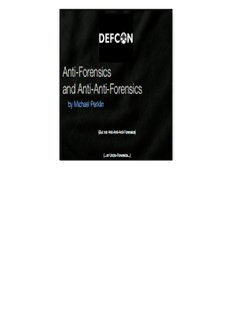
Anti-Forensics and Anti-Anti-Forensics - Def Con PDF
Preview Anti-Forensics and Anti-Anti-Forensics - Def Con
Anti-Forensics and Anti-Anti-Forensics by Michael Perklin (But not Anti-Anti-Anti-Forensics) (...or Uncle-Forensics...) Outline Techniques that can complicate digital-forensic examinations Methodologies to mitigate these techniques Other digital complications This talk will deal with a variety of complications that can arise in a digital investigation Michael Perklin Digital Forensic Examiner Corporate Investigator Computer Programmer eDiscovery Consultant Basically - A computer geek + legal support hybrid Techniques in this talk... Most of these techniques are NOT sophisticated Each one can easily be defeated by an investigator The goal of these techniques is to add man-hours/$$$ High costs increase chances of settlement Wiping a hard drive, or using steganography will not be discussed because they’ve been around for decades Typical Methodologies: Copy First, Ask Questions Later Typically Law Enforcement Assess relevance first, copy relevant All types of investigators Remote analysis of live system, copy targeted evidence only. Enterprise, Private if they have help Methodology #1 is typically used by police Methodology #2 is used by all types of digital investigators Methodology #3 is typically used by Enterprise companies on their employees “Assess Relevance” method typically searches an HDD for one of a few specific keywords. If found, the HDD is imaged for further analysis. Typical Workflow Create Process “Separate Working Data For Wheat from Copy Analysis Chaff” Analyze Prepare Archive Data Data for Report on For Future Relevance Findings Create Working Copy ! - Image the HDD ! - Copy files remotely for analysis Process Data ! - Hash files ! - Analyze Signatures Separate Wheat ! - De-NIST or De-NSRL ! - Known File Filter (KFF) ! - Keyword Searches Analyze For Relevance ! - Good hits or false positives? ! - Look at photos, read documents, analyze spreadsheets ! - Export files for native analysis ! - Bookmark, Flag, or otherwise list useful things Prepare Report ! - Include thumbnails, snapshots, or snippets ! - Write-up procedures (Copy/Paste from similar case to speed up workload) ! - Attach appendices, lists, etc Archive Data ! - Store images on central NAS ! - Shelve HDDs for future use Classic Anti-Forensic Techniques HDD Scrubbing / File Wiping Overwriting areas of disk over and over Encryption TrueCrypt, PGP, etc. Physical Destruction These 3 methods are fairly common amongst people like us In reality, these are used rarely. Each method implies guilt, and can be dealt with without tech. Running Tallies on Slides Tally of # Hours Wasted will be at bottom left Tally of # Dollars Spent will be at bottom right I will assume an average rate of $300/hr for the digital investigator’s time Red tallies indicate costs for current technique Green tallies show total costs to-date 0 hours $0 $300/hr rate is fairly average for junior-intermediate investigators #1. Create a Working Copy Confounding the first stage of the process “Separate Create Process Data Wheat from Working Copy For Analysis Chaff” Analyze Data Prepare Report Archive Data for Relevance on Findings For Future 0 hours $0 Copy each device for later analysis ...or copy the file from the remote live machine AF Technique #1 Data Saturation Let’s start simple: Own a LOT of media Stop throwing out devices Use each device/container regularly if possible Investigators will need to go through everything 8 hours $2,400 Cell Phones Laptops Old HDDs USB Keys Burned CD/DVDs
Description: